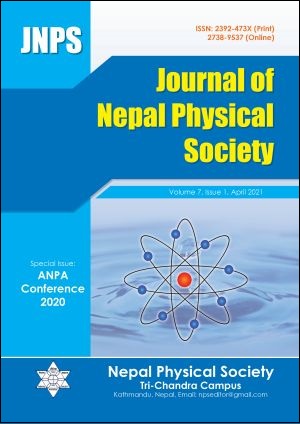Electronic and Transport Properties of Sr-site Substituted: CaxSr(1-x)VO3
DOI:
https://doi.org/10.3126/jnphyssoc.v7i1.36968Keywords:
Complex TMOs, DFT, DMFT, Superstructures, Stongly Correlated SystemAbstract
The Mott-insulator phase transition behaviour of the superstructure of strongly correlated system, CaxSr(1-x)VO3 (x =0, 0.33, 0.67, 1) have studied using the conventional density functional theory and the dynamical mean field theory. The Mott-Hubbard metal-insulator phase transition of superstructures, Ca0.33Sr0.67VO3 and Ca0.67Sr0.33VO3 formed by the CaVO3 and SrVO3 correlated metals, are obtained at U=4.5eV with β= 6(eV)-1 and U =4.5eV with β= 7(eV)-1 respectively. The values of U and β calculated through the Maximum Entropy model using the Green’s function data, are consistent with the experimental results. The value of Seebeck coefficient (S) of superstructure Ca0.33Sr0.67VO3 and Ca0.67Sr0.33VO3 are found to be +0.0011[V/K] and -0.0011[V/K] within the chemical potential μ = -1.266 eV to μ = -0.938 eV. The figures of merit (ZT) are found to be 0.97 at room temperature for these systems. The variation of electrical and thermal conductivities has also been discussed.
Downloads
Downloads
Published
How to Cite
Issue
Section
License
All right reserved. No part of this Journal may be reproduced in any form or by any electronic or mechanical means, including information storage and retrieval system, without permission in writing from the publisher, except by a reviewer who may quote brief passage in a review. The views and interpretation in this journal are those of author(s) and they are not attributable to the NPS.




